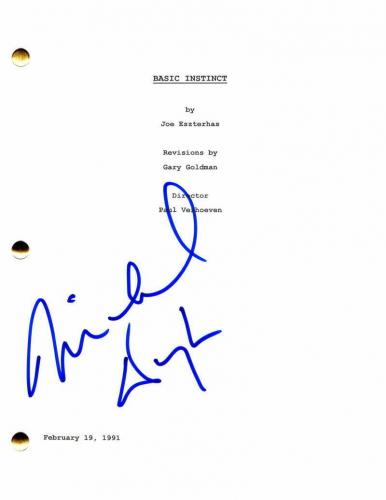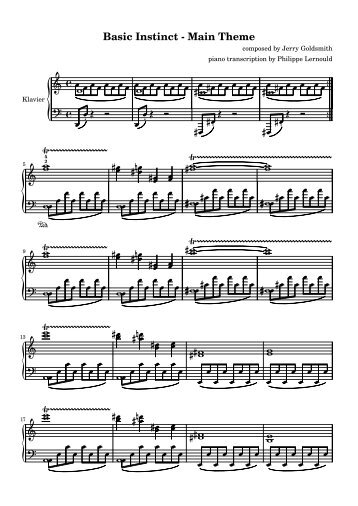Basic Instinct Script Download Pdf

Instinct Plus Purpose Equals Destiny Step beyond Instinct As I quietly stepped onto the elevator and gently pushed the L button to return to the lobby, the incredible blessing I’d just experienced held me spellbound. On the elevator ride down, I pondered the glimpse into history just shared with me. Basic Instinct 2 Synopsis: Crime novelist Catherine Tramell is living in London, and becomes the center of police investigation (yet again) when her football player boyfriend drowns in a car accident and it is revealed that he was already dead because of a drug overdose before Tramell drove the car into water.
- Basic Instinct is a 1992 American neo-noir erotic thriller film directed by Paul Verhoeven and written by Joe Eszterhas. The film follows San Francisco police detective Nick Curran (Michael Douglas), who is investigating the brutal murder of a wealthy rock star.
- Joe Eszterhas wrote Basic Instinct in 10 days. When he was finished, he shipped the script to his agent and sold it three days later for $3 million. Not only is it possible to write a great screenplay in 10 days or less, but spending too much time on a script is actually one of.
By David Trottier
There has been a lot of talk lately about the new spec formatting style. Throughout the 1990s, there has been a movement toward 'lean and clean' screenwriting: Shorter screenplays, shorter paragraphs, shorter speeches, more white space and the omission of technical instructions. It should come as no surprise that this gradual evolution continues to refine spec style. Let's take a quick look at where things stand at this moment in time.

The Technical Stuff
Let's start with what's forbidden. Do not write CONTINUED at the top and bottom of each page. Do not write 'continuing' as a parenthetical when a character continues his/her dialogue after a paragraph of narrative description. Do not number your scenes. I realize this may mean disabling your software; that's because much of the available software is designed to format shooting scripts, while you (most likely) are writing a spec script.
Avoid camera directions: ANGLE ON, CLOSE ON, POV, PAN, DOLLY WITH, TRUCK, ANOTHER ANGLE, ZOOM, PULL BACK TO REVEAL, ZIP PAN, CRANE SHOT, ECU, WE SEE, and so on. Avoid editing directions: CUT TO, DISSOLVE TO, IRIS, WIPE. Notice that I use the word avoid. Avoid means to only use a technical direction when absolutely necessary to move the story forward. That's about two or three times in a screenplay. Remember, you are writing the story, not directing the movie.
More
In the past, when dialogue continued from the bottom of one page to the top of the next, you typed MORE (in parenthesis) below the dialogue, and then typed 'cont'd' (in parenthesis) next to the character's name at the top of the next page. You still do. But only when you absolutely have to. Ideally, your dialogue should be so lean that you don't have to use MORE at all. Just move the entire dialogue block to the top of the next page or cheat a little on your bottom margin to get that last line in at the bottom of the page. (Warning: Do not cheat on your left and right script margins and dialogue margins.)
Parentheticals
You have read that you should use actor's instructions (parentheticals) sparingly, that you should not direct the actor in saying his/her lines unless the subtext is unclear. You've also read that since executives only read dialogue or just a few pages, that you should include some action as a parenthetical to help improve the read. There's truth in both statements. Let's be honest, executives are getting younger, often lack a creative background and are asked to read more. The result is they read less. But readers (professional story analysts) read everything, after which they make their recommendation to the executive or producer. It's that recommendation that places your script in the running for a deal.

In view of that, continue to use parentheticals sparingly, but consider taking occasional opportunities to add a line of action (about 3-4 words) as a parenthetical if doing so adds movement to the scene. And don't be afraid to write a brief description. Film is still a primarily visual medium.
How Lean is Lean?
Try to keep your screenplay within 110 pages, about 100 pages for a comedy and 105 for a drama. Paragraphs of narrative description should not exceed four lines. As a general rule, each paragraph should focus on an image, action or story beat. Thus, paragraphs will often be only a line or two in length. Dialogue lines should not exceed 3.2 inches in width. Ideally, dialogue should consist of one or two lines, maybe three. (Yes, there are exceptions to everything.)
Author's Intrusion
Generally, you should stay out of the script. Shane Black made 'author's intrusion' hip. Here's just one example from page 91 of 'The Last Boy Scout': 'Remember Jimmy's friend HENRY, who we met briefly near the opening of the film? Of course you do, you're a highly paid reader or development executive.' Shane Black can get away with that; you and I can't. But having a personal writing style can add a lot to the read. I loved reading 'Romancing the Stone.' The first line begins, 'A size 16-EE boot kicks through the door....' I came away thinking that Diane Thomas had a lot of fun writing that story. I had a lot of fun reading it.
What Can I Use?
Use the MONTAGE, the SERIES OF SHOTS, the INSERT, the INTERCUT, the FLASHBACK (sparingly) and SUPERs. Use these for dramatic or comedic purposes (or for clarity or ease of reading), not to dress up the script. I have a copy of the original 'Basic Instinct' spec script by Joe Eszterhas -- the one he sold for $3 million. There is not a single DISSOLVE, CUT TO, ANGLE ON, SERIES OF SHOTS, MONTAGE or fancy technique in his entire 107-page script. Only scene headings (slug lines), description and dialogue -- that's it. His focus is on telling a story through clear, lean, unencumbered writing.
Basic Instinct Script Download Pdf Editor
The Bottom Line
Keep in mind that your audience is the reader of your script (not movie-goers) and that he/she is weary of reading scripts. So don't encumber his/her read with technical directions. Just let the story flow like a river. That river will flow if you use visual, clear and concrete language that directs the eye without directing the camera and touches the heart without dulling the senses.
Finally, don't get paranoid about formatting rules; the story is the thing. Readers don't care if you indent 10 spaces or 12 spaces for dialogue, just so long as it looks 'about right,' has a clean appearance, and (most importantly) reads well. Hopefully, your lean script will earn you a fat check.
Youtube Basic Instinct Full Movie
Meet the Author: David Trottier
Basic Instinct Youtube
Dave Trottier has sold or optioned ten scripts and helped countless fellow screenwriters break into Hollywood through his work as an acclaimed script consultant and author of The Screenwriter's Bible, the Industry's de facto spec writing and formatting guide. He also writes a column for Script magazine and hosts keepwriting.com. |